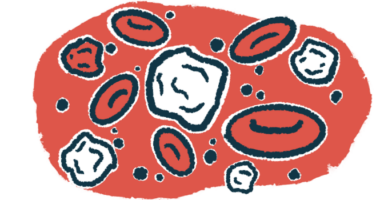NMOSD test therapy BAT4406F depletes B-cells, eases disability
First-in-human study tested single infusion for safety, tolerability

BAT4406F, an experimental treatment in the pipeline of Bio-Thera Solutions, reduced the number of circulating immune B-cells that produce disease-causing antibodies in neuromyelitis optica spectrum disorder (NMOSD), translating into less disability for a small group of Chinese patients.
That’s according to data from a Phase 1 clinical study (NCT04146285) that tested how safe and well tolerated BAT4406F as a single infusion into a vein, or intravenously, was for 15 patients who were positive for antibodies against the protein aquaporin 4 (AQP4), those most commonly linked to NMOSD.
Along with exploring how well BAT4406F may work on NMOSD, this first-in-human study also tested the therapy’s pharmacokinetics, that is, how a medicine moves into, through, and out of the body; its effects in the body, or pharmacodynamics; and its potential to trigger unwanted immune reactions.
The findings were detailed in the study, “First-in-Human Study of BAT4406F, an ADCC-Enhanced Fully Humanized Anti-CD20 Monoclonal Antibody in Patients With Neuromyelitis Optica Spectrum Disorders,” in CNS Neuroscience & Therapeutics, as announced by Bio-Thera in a company press release.
In NMOSD, the immune system launches repeated inflammatory attacks that damage the optic nerves and spinal cord, which leads to symptoms such as blurry vision, numbness, or weakness in the arms and legs. The disease is most commonly associated with the presence of self-reactive antibodies that target AQP4.
Like rituximab, an antibody-based therapy that’s used off-label in NMOSD to prevent symptom worsening, BAT4406F is designed to attach to the CD20 protein on the surface of B-cells. When the therapy binds to CD20, it prompts other immune cells to destroy B-cells.
In preclinical studies involving monkeys and blood from healthy people, more B-cells were destroyed with BAT4406F than with rituximab or other antibody-based therapies that work similarly. BAT4406F was also well tolerated when given as an intravenous infusion to animals.
Results of Phase 1 study
The Phase 1 clinical study included 14 women and one man, all of Han ethnicity. They ranged in age from 26 to 64 and all had a history of relapses, or episodes when symptoms suddenly worsen or new ones appear. Most (86.7%) had been on treatments for NMOSD, including corticosteroids or immunosuppressants.
The patients were divided into five dose groups (20, 100, 200, 500, and 750 mg), with three patients in each group. All 15 patients received a single intravenous infusion of BAT4406F. Most (86.7%) stayed relapse-free over six months and completed the study, while two (13.3%) relapsed and withdrew early.
The two who withdrew had stopped taking corticosteroids shortly after receiving BAT4406F, which may have led to relapses before BAT4406F could take full effect. Their doses (20 and 200 mg) also may have been too low to be effective, the researchers said.
BAT4406F rapidly reduced the number of circulating B-cells in all dose groups, with higher doses leading to greater and longer-lasting depletion. Four days after treatment, the 500 and 750 mg doses nearly eliminated B-cells, maintaining low counts for six months. Lower doses resulted in earlier recovery of the pool of B-cells.
Disability was evaluated using the Expanded Disability Status Scale, where higher scores indicate a greater degree of disability linked to the disease. After six months, patients in the 100, 500, and 750 mg dose groups showed reductions by up to 1.25 points, indicating a lower degree of disability.
In some patients receiving 200 mg or more, MRI scans of the optic nerves improved from abnormal to normal. In the spinal cord, improvements were seen in patients who received 100 mg or more. These changes seen in higher-dose groups, “may be related to the therapeutic effect” of BAT4406F, the researchers wrote.
Safety of BAT4406F
BAT4406F was safe, with most side effects being mild or moderate in severity. No severe or serious side effects were reported. The therapy’s half-life, or the time it takes for its levels to fall to half the initial levels, was nine to 16.4 days. As the dose was increased, the levels of BAT4406F in the blood also increased. Three patients developed antibodies against BAT4406F, but they didn’t prevent the therapy from working.
“BAT4406F exhibited favorable safety and tolerability in Chinese NMOSD patients,” the researchers wrote. “After treatment with BAT4406F, most subjects remained relapse-free, showing that BAT4406F has the potential to reduce the recurrences of NMOSD.” Further research is needed, they said.
Bio-Thera is assessing the safety, pharmacokinetics, and pharmacodynamics of BAT4406F against a placebo in a Phase 2/3 clinical study (NCT06044350) that’s recruiting up to 162 adults with NMOSD at a number of locations across China. More locations are planned.
After screening, patients will be randomly assigned to receive two intravenous infusions of either BAT4406F (500 mg) or a placebo at an interval of about six months. The patients may then enter an open-label extension to continue BAT4406F if they complete a year of the study without their symptoms returning or if the symptoms come back, but can be controlled with rescue treatment.







